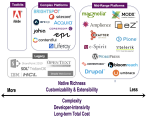Usability still improving -- improvement still needed
In evaluating dozens of products for the Web CMS Report 2010 (to be released tomorrow), we've had the chance to see some interesting user interface redesign efforts. Some of these efforts amount to little more than an array of cosmetic improvements, but others do succeed in making the UI more usable.
The overall trend right now is toward "flatter" UIs that require less mouse-clicking and have fewer "drill points." By drill point, I mean an interface item that, when clicked, opens other interface items that, when clicked, lead to other interface items. Most vendors are starting to understand that system users -- regardless of role -- are busy people who don't want to have to go out of their way to find things or get work done.
So the good news is, the CMS world is a lot flatter now. And in most cases, quite a bit easier on the eyes than, say, two or three years ago. That's actually a very good thing.
But there are still problems, and some of the problems are not really limited to the WCM or ECM or DAM domains specifically; they're endemic in the software world. But in busy New Media environments, poor usability can be especially crippling.
One problem is that interfaces are still too full of text. Some UIs have achieved flatness through a wall-of-tabs/world-of-links approach, and your eyes end up having to distinguish between dozens of short (and some long) text items all over the screen. Cognitively, it's disorienting.
There's also a problem with TMI (yes, too much information) in windows and dialogs. As an end-user, I don't want to be forced to look at useless information in a dialog box. "Useless information" is anything I don't care about at the moment. And that's everything that doesn't help me get my job done. So put a reasonable default value in the control for me, thank you, and put a little question-mark icon alongside the text field (or whatever it happens to be) that I can click to get extra info in case the UI is so non-self-documenting that I need extra info. Better still, let me roll the mouse over the text field (or whatever) to get the info I need, and let there be live links in the tooltip itself that will take me to additional documentation if I need even more info.
A much bigger problem is the proliferation of dialogs and wizards, and (even worse) dialogs that can bring up more dialogs. Dialogs are annoying, in general, because there's usually very little actual "dialog" happening in a dialog box; it's more of a monolog. It's the programmer who wrote the software telling you what to do next, rather than the reverse. If it's a modal dialog, you must obediently satisfy the program's needs before the box will go away and let you get back to work.
Wizards are even more odious, yet we see them recur in all the technologies we cover. A wizard forces you to make a potentially lengthy series of (occasionally complicated) decisions and choices in a particular order. That's not how people ordinarily think or work, though. People tend to be ad hoc, freeform, and non-linear in their working styles. A wizard is designed to defeat that by making you work linearly, in the exact manner a programmer has decided you need to work.
As I say, many vendors have gotten a good bit smarter about making their client-application UIs less intrusive and easier to use. Others are starting to lag the industry, despite having UIs that were (for all intents) "good enough" two years ago. For the inside scoop on which vendors deserve bouquets and which deserve brickbats, I recommend you consult our Web CMS research, where you'll find in-depth evaluations of more than forty products, including a usability analysis for each (plus a lot of other kinds of analysis, of course). Get a running start on usability testing. Subscribe to one of our reports today. Stamp out carpal tunnel syndrome in our lifetime.








